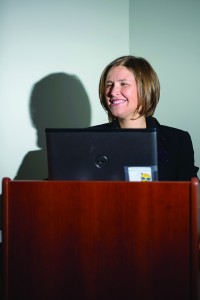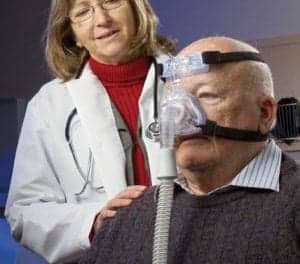As an associate professor at Stony Brook University, author of numerous peer-reviewed articles, and the inaugural editor of the National Sleep Foundation’s new journal, Lauren Hale, PhD, wakes up the country to sleep as a social justice concern.
Sleep Review: You are an associate professor of preventive medicine. How did your interest in sleep arise?
Lauren Hale, PhD: As part of my doctoral training in demography at Princeton University, I studied social epidemiology and the social patterns associated with a range of health and mortality outcomes. Typically, demographers call this the “social gradient with health,” meaning that individuals with lower levels of socioeconomic status have worse health outcomes. For my dissertation, I investigated longitudinal data on a large cohort of individuals and examined how social experiences over the life course shaped health outcomes. Early on in my analyses, I realized that even though we had detailed data across many points in life, we were not able to capture how individuals with divergent life experiences slept. During this same period, I watched Robert Stickgold lecture on the importance of sleep for learning and memory. This lecture further convinced me about the importance of sleep for shaping life trajectories and even health outcomes. At the end of the talk, Professor Stickgold stated, “We don’t know anything about the demography of sleep.” That was the moment I decided that my future research would pursue that direction.

People with the highest levels of education are the most likely to sleep the recommended amount, says Dr Hale. People with lower levels of education are more likely to have sleep apnea and insomnia.
SR: For those who are not aware of sleep as a social justice issue, can you explain how individual, social, and demographic factors affect the sleep that entire populations typically get?
Hale: People in socially disadvantaged positions experience a disproportionate amount of sleep problems. For example, people with the highest levels of education are the most likely to sleep the recommended amount. People with lower levels of education are more likely to have both sleep apnea and insomnia. We also find that social and marital relationships matter for sleep. Married people sleep better than single people, and people in healthy marriages sleep better yet. Further, employment matters for sleep. Having a job is associated with better sleep, perhaps because it gives you regular routines, financial security, and a purpose for your days. And, of course, the type of job matters as well. With 15% of the workforce working irregular or shift hours, these irregular schedules are not conducive to restful sleep. Finally, sleep is intricately linked with mental health—depression and anxiety are both causes and consequences of poor sleep.
SR: What about behavioral factors, such as exposure to screen time and caffeine consumption?
Hale: Individual behavioral factors, such as screen time exposure and caffeine consumption, certainly contribute to sleep quality and quantity in our hyperconnected society. Most of us can take steps to improve our sleep hygiene, with 95% of Americans reporting using screen-based technology in the hour before bedtime. I am curious about whether certain populations are at higher risk of excessive screen time, or caffeine consumption. There are not many studies that have looked specifically at social disparities in specific sleep hygiene behaviors.
SR: Can you explain how socioenvironmental factors, such as cultural environment and noise levels, can affect sleep?
Hale: Socioenvironmental factors play a large role in shaping sleep patterns. One clear area to observe the differences is to compare the sleep of urban residents to nonurban residents. We have found that residents of densely populated urban areas get less sleep than those who live outside of the central city, possibly due to noise, light, feelings of safety, and cultural differences in behaviors during the evening hours.
SR: What are the long-term consequences when certain populations can’t get adequate sleep?
Hale: Those who are most socially advantaged wake up the most prepared for their days. They feel better and function better in all ways. This cycle gives the already advantaged an additional advantage in their family lives, in their workplaces, and with regard to their physical and mental health. Given the numerous dimensions in which sleep affects well-being (psychosocial, economic, and physical), it is challenging to quantify the cumulative long-term consequences, but the message is clear: Getting sufficient restorative sleep contributes to a positive feedback loop of accomplishment, security, and future nights of high-quality restorative sleep.

Hale has authored more than 55 published articles in Sleep, Sleep Medicine Reviews, Journal of Sleep Research, Pediatrics, and numerous other peer-reviewed journals. Her research focuses on the social determinants of sleep and the role of sleep in health disparities.
SR: In your research, what has surprised you the most?
Hale: We have found that first-generation immigrants sleep better than the rest of us. The more acculturated immigrants are to the American lifestyle, the worse their sleep. Additionally, the National Sleep Foundation (NSF) 2013 Sleep in America Poll: International Bedroom Poll outlines some key cultural differences in sleep.
SR: Can you share any success stories of sleep being restored?
Hale: One very interesting study with a pre-post design, by Guido Simonelli, showed that the provision of basic prefabricated housing to slum residents in Buenos Aires, Argentina, improves both sleep quality and quality of life among slum dwellers. There are other studies underway with experimental designs, which provide a stronger test of causality. I am working with Wendy Troxel and Tamara Dubowitz on a study that compares sleep patterns of two similar low-income, predominantly minority neighborhoods in Pittsburgh. One of the neighborhoods (the experimental condition) received a significant investment to increase green space, access to grocery stores, and improved neighborhood aesthetics and housing, while the other neighborhood (the control condition) did not get this investment. This type of study will help us better understand whether improving neighborhood conditions can improve sleep in a population at high risk for sleep disorders, in addition to other conditions, like obesity and chronic health conditions. Additionally, Orfeu Buxton at Penn State University, along with Work, Family, and Health Network colleagues, has used a controlled, randomized, experimental design to investigate the effect of a workplace cultural intervention to reduce work-family conflict to see how the intervention affects sleep among employees. These are the types of high-quality policy-relevant studies we hope to publish in the forthcoming journal Sleep Health.
SR: Have you noticed any trends in the public perception of sleep?
Hale: For nearly 25 years, the National Sleep Foundation has been a leading voice for improving health and well-being through public sleep health education and advocacy. Over the last decade, I’ve seen NSF’s efforts taking effect in the public arena with new energy. The general public, the medical community, and federal health agencies have greatly increased their interest in treating sleep as a public health priority. For example, at NSF’s urging, the Centers for Disease Control and Prevention’s Healthy People 2020 initiative now includes the improvement of sleep health of the population as a priority. Given these public perceptions and growing interest, we at the NSF are eager for our new Sleep Health journal to publish articles about how policies can influence sleep and improve the health of the population.
SR: You are the principal investigator of a study examining the sleep, physical activity, and screen time patterns of teenagers in an ongoing birth cohort study. What are some of the latest findings?
Hale: We are still in the first year of data collection in our 5-year study and we have not yet scored the actigraphy data. However, preliminary analyses of the daily diary data show that, not surprisingly, today’s teenagers are going to bed late (after 11 pm) and waking up early (at or before 6 am); these patterns suggest that they are not getting enough sleep. We have found that the strongest predictors of going to bed after 11 pm are watching television in the hour before bedtime, having two or more caffeinated drinks during the day, and also doing homework in the hour before bedtime. Using our objective measures of sleep, repeated measures, and longitudinal study design, we will be able to look at the associations among sleep, physical activity, screen time, obesity, and depression.
SR: You are a co-investigator on an analysis of retirement and sleep trajectories in the Wisconsin Sleep Cohort. What are some of the latest findings?
Hale: I am working with Paul Peppard and his awesome team at the University of Wisconsin-Madison. We are studying how poor sleep during working years affects retirement decisions and how sleep habits and disorders are affected by the work-to-retirement transition. We are using four annual waves of longitudinal data from almost 2,000 adults from a population-based study in Wisconsin known as the Wisconsin Sleep Cohort. Our preliminary findings show that insomnia at midlife is associated with an increased risk of earlier retirement. As for what happens to sleep during the work-to-retirement transition, we are still in the final wave of data collection, so we don’t have our key findings yet.

Hale is associate professor of Preventive Medicine in the Program in Public Health at Stony Brook University.
SR: Is there anything sleep professionals can incorporate into their practices or sleep centers to help address social justice issues regarding sleep?
Hale: This is a great question. Sleep professionals should, at a minimum, be aware of the basic social patterning of sleep. This could help guide professionals in how they talk to their patients about what factors in their life might be contributing to their sleep beliefs, attitudes, and behaviors. Further, they may take interest in how policies and institutions can make changes that can improve sleep health.
SR: Is there anything else you’d like to add that I didn’t ask you about?
Hale: As we are bringing Sleep Health into the world, I’m a few weeks away from giving birth to my second child. One of the most important things I’ve learned from parenting is that there are often many constraints that get in the way of theoretically ideal parenting behaviors (eg, nutritional choices, sleep routines, screen time exposure). Parenting requires a lot of compromise and sacrifice. Similarly, prioritizing one’s sleep is often difficult given the constraints of daily life. Becoming a parent has helped me become even more understanding of the fact that not every problem has an easy solution. With regard to sleep choices, for example, if a single mother has to make a choice between taking on an extra job to pay her bills and getting sufficient sleep, she will likely choose the route that is best for her family. Addressing some of the sleep challenges of the population may require changes at the structural and societal levels beyond simply treating individuals. The first step may be for people to become aware of how important sleep is to their overall health and well-being; this is at least a move in the right direction. SR
Sree Roy is editor of Sleep Review. CONTACT [email protected].





